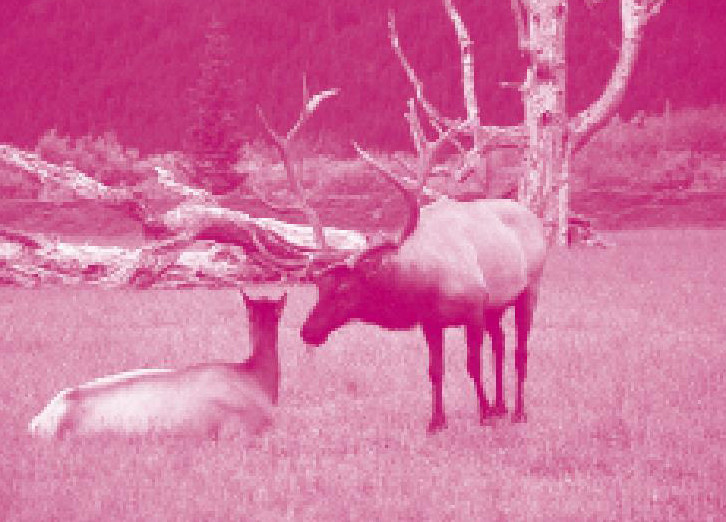
打开文本图片集
Have you ever wondered what wild animals do when no one is watching?
Scientists have been able to document the “private” moments of wildlife with leading-edge technology. Low-cost and small modern cameras amount to a big help.
Cameras placed in hard-to-reach places have captured images of everything from small desert cats called ocelots to larger felines called lynx in the northern Rocky Mountains.
Grant Harris is a government biologist with the United States Fish and Wildlife Service in Albuquerque, New Mexico. In his words, “there’s no doubt,” that these rural cameras are important tools to learn new information on wildlife.
Harris said, “Some images help scientists see the effects of climate change. For example, the desert animal javelina and the tree-loving coatimundi have been caught on cameras north of their normal habitat. This could mean global warming is expanding their range northward.”
Researchers with the Wyoming Migration Initiative, or WMI, are among those using rural cameras along with global positioning systems, or GPS.
They attach GPS devices to elk, mule deer and antelope in and around Yellowstone National Park. Then they can record their movements, or migrations. But WMI director Matthew Kauffman says as those devices are limited so is the amount of information they can gather from GPS.
“You see one animal migrating, but you don’t know if it’s migrating by itself, if it’s migrating with a calf, or if it’s migrating with 40 other animals,” Kauffman said.
“However, cameras can be left in rural areas for days, weeks or even months. They can provide information on how many animals are moving over a given period of time,” he said.
Rural video can show details about animal behavior, such as the calls made by migrating mule deer. Also, some cameras live-stream animal life, showing everything from bison in Saskatchewan, Canada, to the underwater kelp forest off California’s Channel Islands.
However, rural cameras have their problems too. Animals such as wolverines and bears sometimes attack them. Scientists do not know if the attacks are the result of anger or interest.
Also, the devices have become popular tools to help hunters look for animals. Some people argue that it is unfair to use the cameras that way.
Even with such problems, rural cameras are clearly an important scientific tool in researching wild animals.
你有沒有想过野生动物在没人观察的时候,它们会做些什么呢?
科学家已经能够运用尖端技术记录野生动物的“私人”时刻。低成本、外观小巧的现代摄影机给予了他们很大的帮助。
放置在人们难以触及的地方的摄影机已经捕捉到从称之为豹猫的小型沙漠猫到生活在洛基山脉北部雪域的较大型猫科动物猞猁的所有影像。
格兰特·哈里斯是一名在新墨西哥州阿尔伯克基市的美国鱼类与野生动物管理局工作的生物学家。用他的话说:“毫无疑问”,这些野外摄影机是了解野生动物新信息的重要工具。
哈里斯说:“一些影像可以帮助科学家了解气候变化带来的影响。例如,沙漠动物西貒(一种野猪)和喜欢树木的长鼻浣熊已被安装在它们的正常栖息地以北的摄影机拍摄到。这可能意味着全球变暖正在向北扩展。”
怀俄明州迁徙计划(WMI)的研究人员也在使用野外摄影机和全球定位系统(GPS)。
研究人员把GPS设备安装到黄石国家公园内及其周围的麋鹿、长耳鹿和羚羊身上,那么他们就可以记录这些动物的行踪或者迁徙。但是怀俄明州迁徙计划的主管马修·考夫曼表示,由于设备有限,所以他们通过GPS搜集到的信息也是有限的。
考夫曼说:“你看到一只动物正在迁徙,但是你不知道它是独自迁徙,还是和一头小牛迁徙,抑或是和40只其他动物一起迁徙。
然而,摄影机可以在野外工作数天、数周甚至数月。它们可以提供在一段特定的时间内有多少动物正在迁移的信息。”
野外录像可以显示关于动物行为的细节,例如在迁徙过程中的长耳鹿發出的叫声。此外,一些摄影机可以现场直播动物的生活,展示从加拿大萨斯喀彻温省的野牛到靠近加利福尼亚州海峡群岛的水下海藻丛林等一切动植物的生活。
但是,野外摄影机也会遇到麻烦。狼獾和熊等动物有时会破坏野外摄影机。科学家们还不清楚动物的这些攻击行为是出于愤怒还是好奇。
此外,这些设备已经成为帮助猎人寻找猎物的流行工具。一些人认为猎人使用摄影机寻找猎物是不正当的行为。
即使存在这样的问题,野外摄影机也无疑是研究野生动物的重要科学工具。
Word Study
document /"dɒkjument/ v. 记录
He wrote a book documenting his prison experiences.
capture /"kæptʃə(r)/ v. 捕捉;拍摄
He captured his daughter’s smile in this photograph.
migration /maɪ"ɡreɪʃn/ n. 迁移;迁徙
More than half the rise in the population of England and Wales was due to migration.
gather /"ɡæðə(r)/ v. 搜集
He was busy gathering information about birds.

